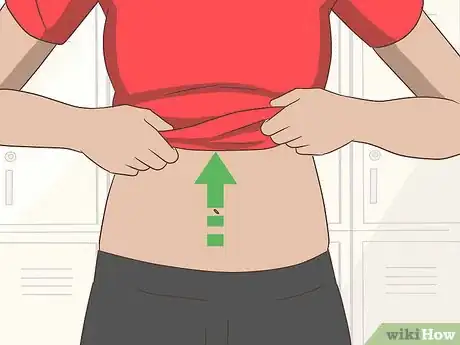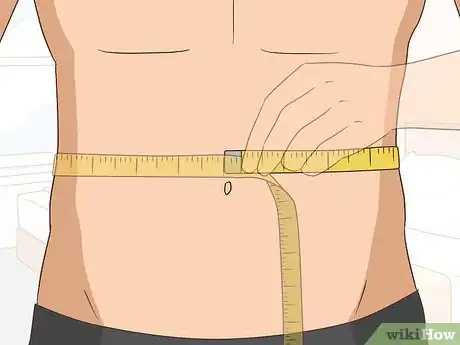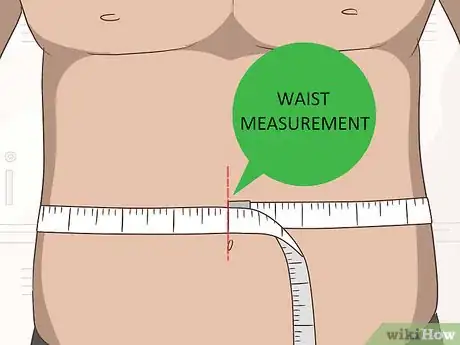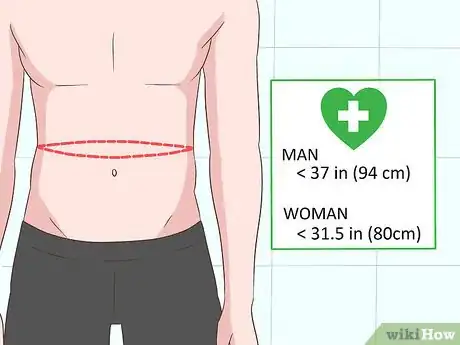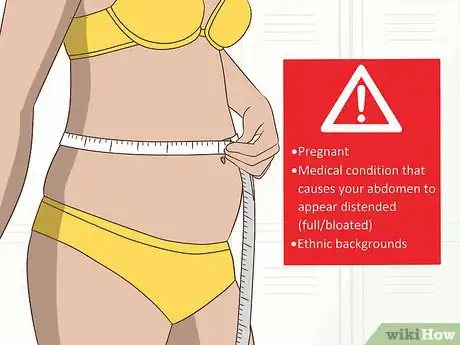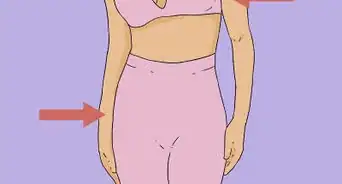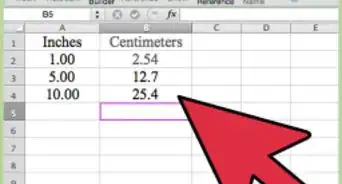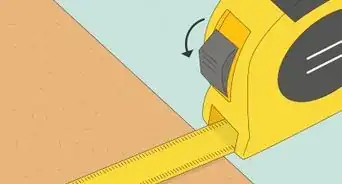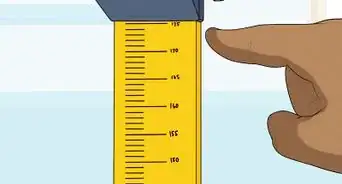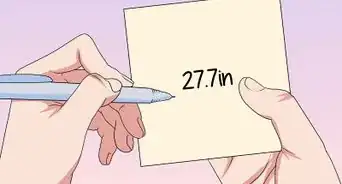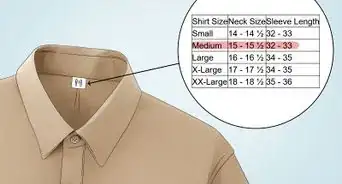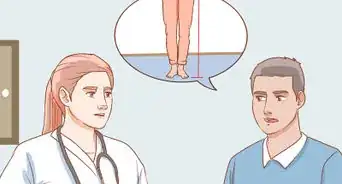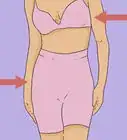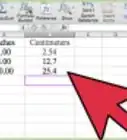This article was co-authored by Laila Ajani. Laila Ajani is a Fitness Trainer and founder of Push Personal Fitness, a personal training organization based in the San Francisco Bay Area. Laila has expertise in competitive athletics (gymnastics, powerlifting, and tennis), personal training, distance running, and Olympic lifting. Laila is certified by the National Strength & Conditioning Association (NSCA), USA Powerlifting (USAPL), and she is a Corrective Exercise Specialist (CES).
wikiHow marks an article as reader-approved once it receives enough positive feedback. In this case, several readers have written to tell us that this article was helpful to them, earning it our reader-approved status.
This article has been viewed 2,614,777 times.
Your waist size can both help you choose the perfect pair of jeans and keep track of your weight, and it's really easy to measure. Your waist begins at the top of your hip bone and travels up to just below your ribcage, so it’s easily accessible with a tape measure. This article will show you how to quickly take your waist measurements and how to interpret those numbers.
Steps
Taking the Measurement
-
1Remove or raise clothing. To get an accurate measurement, you need to ensure that the tape measure is resting against your bare stomach, so you should remove any layers of clothing blocking your waist. Remove your shirt or lift it to just below your chest. If your pants are in the way, undo them and pull them down around your hips.
-
2Find your waist. Use your fingers to find the top of your hips and the base of your rib cage. Your waist is the soft, fleshy section between these two bony parts.[1] It will also be the narrowest part of your torso and it is often located at or above your belly button.EXPERT TIPLaila Ajani is a Fitness Trainer and founder of Push Personal Fitness, a personal training organization based in the San Francisco Bay Area. Laila has expertise in competitive athletics (gymnastics, powerlifting, and tennis), personal training, distance running, and Olympic lifting. Laila is certified by the National Strength & Conditioning Association (NSCA), USA Powerlifting (USAPL), and she is a Corrective Exercise Specialist (CES).Fitness Trainer

 Laila Ajani
Laila Ajani
Fitness TrainerOur Expert Agrees: When you're measuring your waist, look for the smallest part of your waist, which is usually a little higher up than most people think. It's usually a little bit above your navel. If you want to measure your hips as well, it's the opposite—you want to measure where your hips and glutes are the widest.
Advertisement -
3Wrap the measuring tape around your waist. Stand up straight and breathe normally. Hold the end of the tape measure at your navel and circle it around your back to the front of your waist. The measuring tape should be parallel to the floor and fit snugly around your torso without digging into your skin.[2]
- Make sure that the measuring tape is straight all the way around and is not twisted anywhere, especially in the back.
-
4Read the tape. Exhale and then check the measurement on the tape.[3] Your waist measurement will be at the place on the tape where the zero end meets the slack end of the tape measure. The number indicates your waist measurement in inches and/or centimeters, depending on the type of measuring tape you used.
-
5Double-check your measurement. Repeat the measurement once more to ensure the accuracy of your original measurement. If it is different from the first time, measure for a third time and take the average of the three numbers.
Interpreting the Results
-
1Check to see if your measurement is healthy. A healthy measurement for a man is less than 37 inches (94 cm) or less than 31.5 inches (80 cm) if you are a woman.[4] A measurement that is higher than the number indicated for your sex may predispose you to serious medical problems, such as heart disease and stroke.[5] A higher waist measurement may also predispose you to type 2 diabetes and cancer.[6]
- If your measurement is outside of the healthy range, then you may want to talk to your doctor.
-
2Consider any factors that may reduce the usefulness of your result. In some situations, a waist measurement is not a helpful indication of good health. For example, if you are pregnant or if you have a medical condition that causes your abdomen to appear distended (full or bloated), then waist measurement may be outside of the healthy parameters even if you are in good health. Likewise, some ethnic backgrounds predispose people to a larger waist size, such as people who are of Chinese, Japanese, South Asian, Aboriginal, or Torres Strait Islander descent.[7]
-
3Check your BMI for more information on your weight. If you are not sure whether or not you are in a healthy weight range after taking your waist measurement, then you may also consider checking your BMI (Body Mass Index).[8] This measurement takes your weight and height into account to determine whether or not you may need to lose weight.[9]
- If your BMI result indicates that you are overweight or obese, talk to your doctor about your options for achieving and maintaining a healthy weight.
Expert Q&A
-
QuestionWhat is my ideal waist size if I am 5'9 and 86 kg?
 Michele DolanMichele Dolan is a BCRPA certified Personal Trainer in British Columbia. She has been a personal trainer and fitness instructor since 2002.
Michele DolanMichele Dolan is a BCRPA certified Personal Trainer in British Columbia. She has been a personal trainer and fitness instructor since 2002.
Certified Fitness Trainer At 5'9" you are 69" tall, and half that amount is the cut off for healthy to normal waist size, so that would be 34.5 inches. More than 34.5 inches indicates a greater predisposition for health risks.
At 5'9" you are 69" tall, and half that amount is the cut off for healthy to normal waist size, so that would be 34.5 inches. More than 34.5 inches indicates a greater predisposition for health risks. -
QuestionHow do you measure your waist for pants?
 Michele DolanMichele Dolan is a BCRPA certified Personal Trainer in British Columbia. She has been a personal trainer and fitness instructor since 2002.
Michele DolanMichele Dolan is a BCRPA certified Personal Trainer in British Columbia. She has been a personal trainer and fitness instructor since 2002.
Certified Fitness Trainer This really depends on the style of the pants. Find out how high the pant waist line rises. Take the measurement from there. Low and medium rise pants have much bigger waistlines, since they fall below your natural waist (the skinniest part of your waist).
This really depends on the style of the pants. Find out how high the pant waist line rises. Take the measurement from there. Low and medium rise pants have much bigger waistlines, since they fall below your natural waist (the skinniest part of your waist). -
QuestionWhat should the average waist be for 4' 11", weighing 139 lbs?
 Michele DolanMichele Dolan is a BCRPA certified Personal Trainer in British Columbia. She has been a personal trainer and fitness instructor since 2002.
Michele DolanMichele Dolan is a BCRPA certified Personal Trainer in British Columbia. She has been a personal trainer and fitness instructor since 2002.
Certified Fitness Trainer People come in all shapes and sizes so average waist size is irrelevant. The important size is half your height. At 59 inches tall, a healthy waist size for you would be under 29.5 inches.
People come in all shapes and sizes so average waist size is irrelevant. The important size is half your height. At 59 inches tall, a healthy waist size for you would be under 29.5 inches.
References
- ↑ https://www.heartfoundation.org.au/your-heart/know-your-risks/healthy-weight/waist-measurement
- ↑ https://www.wcrf-uk.org/uk/here-help/health-tools/how-measure-your-waist
- ↑ https://www.heartfoundation.org.au/your-heart/know-your-risks/healthy-weight/waist-measurement
- ↑ https://www.wcrf-uk.org/uk/here-help/health-tools/how-measure-your-waist
- ↑ https://www.heartfoundation.org.au/your-heart/know-your-risks/healthy-weight/waist-measurement
- ↑ https://www.nhs.uk/chq/Pages/849.aspx?CategoryID=51
- ↑ https://www.heartfoundation.org.au/your-heart/know-your-risks/healthy-weight/waist-measurement
- ↑ https://www.nhs.uk/chq/Pages/849.aspx?CategoryID=51
- ↑ https://www.nhlbi.nih.gov/health/educational/lose_wt/BMI/bmicalc.htm
About This Article
To find your waist measurement, first raise or remove your shirt, then stand up straight and exhale your breath. While in this position, hold the end of a tape measure to your navel and wrap it around the narrowest section of your waist. Make sure the tape measure is snug and parallel to the ground. For tips from our reviewer on reading the tape measure, scroll down!
